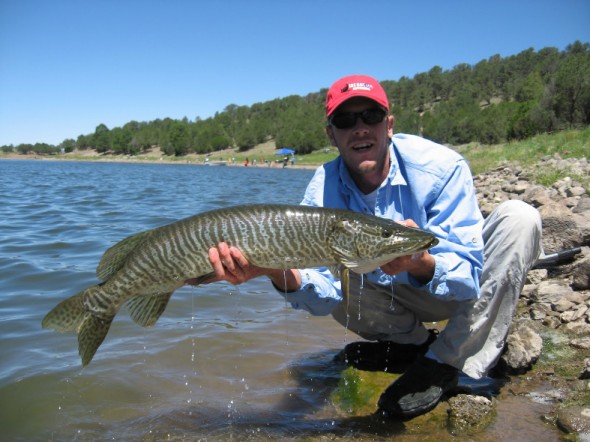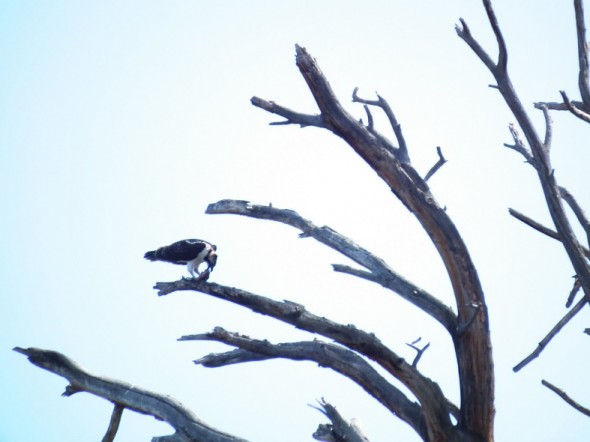
Matt Pelletier of New Mexico Muskie’s Inc shows off a typical catch at Quemado Lake, Fall 2010. Photo courtesy of Pelletier.
It’s New Mexico’s latest fishing craze, anglers trying to catch giant, 40-inch, 20-pound tiger muskies lurking in the depths of Quemado and Bluewater lakes where they’ve been stocked to prey upon undesirable fish.
“People are coming from all over the place to catch these,” says Matt Pelletier of New Mexico Muskies Inc., a newly formed, non-profit club, dedicated to the sport. “And it’s a real rush when you get into one.”
The predators, a cross between a muskie and a pike produce a sterile hybrid that can be raised in hatcheries and then stocked in lakes to help control undesirable fish populations.
The New Mexico Department of Game and Fish (NMDGF) has been stocking tiger muskies in Quemado and Bluewater lakes for the past several years to rid these waters of increasing populations of white sucker and goldfish.
These kinds of undesirable fish compete with sport fish, like trout, for the available habitat which in turn leads to reduced angler satisfaction at these locations. At one point Quemado Lake was virtually overrun with goldfish and trout fishing was almost nonexistent.
But the stocked tiger muskies have gone about their deadly work for several years, chasing down and eating their intended victims and some anglers have since turned to catching them, strictly on a required catch and release basis.
But the tiger muskies have done such a good job in reducing the undesirable fish populations at both lakes that the state Game Commission has recently ruled that anglers can now catch and keep a trophy size tiger muskie from either lake.
For example, Quemado has seen its goldfish population diminish considerably as revealed during an August, 2010 NMDGF survey that picked up 34 goldfish an hour during electro-shocking. In 2008 the number was 157 goldfish an hour while in 2006 the number was much higher at 377 goldfish an hour, according to the NMDGF’s coldwater fisheries biologist, Richard Hansen.
Surveys results lead researches to believe that Quemado Lake holds a population of about 1,100 Tiger Muskies over 18-inches in length. During the fall electro shocking survey 30 tiger muskies were netted with the average size coming in at 33-inches and the largest weighing in at 19-pounds and 43-inches in length.
During the same survey 62 trout were caught with the average size being 18-inches indicating the popular sport fish is thriving in Quemado Lake despite the addition of larger predators to the environment.
Pelletier says that’s because the tiger muskies like to eat exactly what they were introduced for, the goldfish and suckers.
That’s good news for trout anglers who in recent years may have given up on Quemado Lake.
An early November trip to the lake on a warm sunny Saturday revealed good fishing with several young tigers netted along with a trophy sized trout and a giant grass carp.
Bluewater Lake enjoys similar results and plenty of tiger muskies to be caught. (See related article, “Record Breaking, Trophy Sized Tiger Muskies at Bluewater Lake NM” for more info.)
Pelletier says his organization was formed to help educate anglers about the sport and assist the state in improving, protecting and promoting the tiger muskie fisheries.
For instance, the club raised $5,400 through a grant from the Hugh C. Becker Foundation to purchase minnows to feed tiger muskies being reared at the state’s Rock Lake Fish Hatchery. This helps keep the young predators from preying on each other while raised at the hatchery.
The club boasts 56 members, welcomes new anglers and meets about once a month in the Albuquerque area. The meetings are open to the public, Pelletier says.
Anglers wishing to fish for tiger muskies should be aware of some special equipment needed to do so successfully.
Anglers will need at least a seven foot long, heavyweight rod capable of handling at least a 20-weight line an one ounce lure with an open face spinning or bait casting reel. Wire leaders are recommended and typical lures would include jerk baits that resemble goldfish, suckers and perch.
Anglers should be equipped with a pair of long, needle nose pliers for dislodging hooks. A pair of heavy nippers for cutting hooks off if needed and a pair of jaw spreaders to open the fish’s mouth and get at embedded hooks.
A very large net or preferably, a sling net, in which the fish can be cradled in the water is a necessity for handling the fish properly without harm to itself or the angler.
“We practice and preach catch and release to conserve the resource,” Pelletier says.
Those fishing for tiger muskies need to practice patience and persistence as the fish feed on a limited schedule and anglers need to have their lures in the water when that occurs, Pelletier says.
Tiger muskies have a slow metabolism and after a good sized meal may not eat again for some time which accounts for their sporadic feeding behavior.
The key to attracting a strike from a tiger muskie is to capitalize on its opportunistic, predatory instinct with jerks and motion of the lure that imitate a wounded or struggling prey, Pelletier said.
For more information about the fish, catch and release techniques and some awesome photos check out the club’s website at http://www.newmexicomuskiesinc.org.










